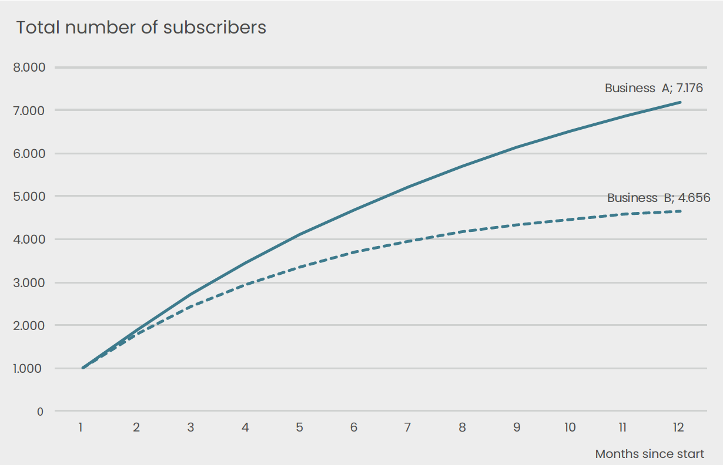This customer retention guide introduces you to one of the most important issues for a subscription business: How to retain subscribers once you have sold the initial subscription. Subscription businesses that manage to retain their subscribers by engaging them with their product and by building loyalty are by far the most successful.
To illustrate the importance of customer retention, let’s look at this example:
Consider two different subscription businesses which both operate monthly subscriptions. Business A manages to retain 90% of subscriptions each month, while the monthly retention rate for business B is 80 percent.
Business A sells 1,000 new subscriptions each month. After a year, its total number of subscriptions is 7,176. How many subscriptions does business B have after a year, if it sells the same number of subscriptions per month? The answer is 4,656.
In fact, business B needs to sell 1,550 new subscriptions each month to reach the same total of subscribers after a year as business A. In other words, because of the ten percent difference in retention rates, business B must sell 55 percent more new subscriptions each month than business A to achieve the same number of subscribers!

Step 1: Define and build an onboarding strategy
You must start the process of building loyalty and ensuring long-time retention of your subscribers as soon as they have signed up for your service. Be sure to welcome your new subscribers and make them feel like you are glad to have them. This process is called onboarding, which is getting your subscribers on board with the service and giving them a reason to stay.
You can do this by engaging them with a welcoming e-mail flow, by getting them to use your product straight away, and by rewarding desired behavior, like recommending your service to family and friends.
And how long does the onboarding period last? This differs from company to company, but try to think of the first month, at least, as a period where you have a special obligation to welcome your new subscribers.
Want more insights on Onboarding Strategies? Download our free e-book here!
Step 2: Define and build a loyalty strategy
When creating your loyalty strategy, a good tip is to use what we call loyalty drivers. These are designed to increase loyalty and hence the amount of time subscribers stay subscribed to your product or service for. We distinguish between primary loyalty drivers and secondary loyalty drivers.

Primary loyalty drivers are characterized by loyalty elements that are built into the core product itself. They become part of the service offering for the subscribers. One example of a primary loyalty driver is gamification. Gamification is simply about applying game mechanics and experience design to your service.
This could be in the form of points, levels, and badges. Many e-learning subscription services and health and training services are using gamification to engage their subscribers and get them to use the service as much as possible.
Secondary loyalty drivers are about building bonus or benefit programs to go with your subscription service. Programs that will reward customers’ loyalty with bonuses, incentives, and benefits, to increase customer satisfaction and hence the value and lifetime of your customers.
Loyalty programs are built around the idea that your customers earn points every time they make a purchase or every time, they renew their subscription. These points can later be used to make new purchases or be used as discounts on future subscriptions. The aim of these programs is to reward your customers’ loyalty to improve customer retention. You can even design programs so that the more your customers buy, or the longer they stay with you, the more points they earn.
Want more insights on Loyalty Drivers? Download our free e-book here!
Step 3: Define and build a customer service strategy
The first step in defining your customer service strategy is to decide how to develop effective customer service that allows your customers to communicate with you about their subscriptions. This is crucial for effective customer retention.
It might seem obvious to mention, but it cannot be said too often: High-quality customer service is a cornerstone when it comes to building loyalty and retaining your subscribers.
Providing your subscribers with superior customer experiences will increase their satisfaction and improve loyalty and hence raise the probability of them continuing to stay with your business.

One important aspect of customer service in a subscription business is to give your subscribers the ability to manage their own subscriptions. In its very nature, a subscription is an ongoing relationship between customer and company, and from time to time a subscriber will need to make changes to their subscription. Therefore, you should provide subscribers with an easy way to manage these changes themselves on a self-service platform. Depending on your business, these changes might be changes of address, updating card details, upgrades, or downgrades, or cancellations.
Giving your subscribers self-service access will also give you more time to focus on those customer contacts which require answers and actions from your side. First, you need to give your subscribers diverse access routes to contact you directly when they have problems that need answers. They might want to phone you, e-mail you, or use online chat to reach you, and the quicker you are able to respond, the better and more trustworthy you will look in your customers’ eyes.
Want more insights on Customer Service Strategies? Download our free e-book here!
Step 4 – Define and build a customer dialogue program
By dialogue program, we simply mean a well-defined communication flow targeted at current subscribers and executed through one or more communication channels. Most typically you would use e-mail as the sole or the main channel of communication when setting up your dialogue program, but other channels might also be relevant.
First, you need to build a dialogue program that aims at welcoming new subscribers to your product or service. This program should of course build on the guidelines and principles outlined in step 1.
The onboarding program is just the start. Following that, you need to define, design, and implement a dialogue program that allows you to communicate with all your subscribers about new product features and how to use the service. The simplest version of this would be a newsletter sent to all your subscribers, but you will probably find that a more comprehensive and focused approach is more effective.
You may find that you need to communicate differently with customers depending on different factors, such as the customer segment, what product customers have bought, or where customers are in the customer lifecycle. Remember, the more relevant your communication is to the individual customer, the bigger chances of customer retention.
Want more insights on Customer Dialogue Programs? Download our free e-book here!
Step 5 – Define and describe your churn prevention processes
The fifth and final step in managing customer retention is setting up churn prevention processes.
No matter how hard you try to develop strong relationships with your customers, and no matter how good you are at fostering loyalty, you will always find that some of your customers will consider discontinuing their subscriptions for one reason or another. You have to decide how you are going to persuade those customers not to leave after all – in other words, you need to work with your churn prevention.

The first thing you need to work out is how to tell when a customer is about to leave you. In some cases, subscribers will tell you directly about their intention to cancel their subscription. They will phone your customer service or send you an e-mail regarding their desire to cancel their subscription. In this case, it is easy to establish their intention, but in other cases, the clues available might not be as obvious.
Perhaps one of your subscribers abruptly ceases using your service. Perhaps they stop paying for their subscription. Perhaps the card they use has expired and their card information has not been updated. In these situations, you do not know whether they actually wish to leave your business or simply need a nudge to reactivate their subscription.
Your best move is to draw up a list of all the indicators you can think of which lead you to suspect that a subscriber is about to churn, and then set up processes for preventing cancellations wherever possible.
If a subscriber formally requests to cancel their membership, you have a unique opportunity to enter dialogue with the customer and enquire about their reasons for canceling. If they phone your customer service, you need to have trained staff who are capable of discussing this with the customer and who are capable of suggesting other solutions in order to retain them. Perhaps the cancellation is just a way of expressing frustration or problem which a skilled employee could sort out.
If they write to you, send you an e-mail, or cancel via your self-service platform, you must enter some sort of dialogue electronically, or even by phoning them, in order to try to keep them as a customer.
Want more insights on Churn Prevention? Download our free e-book here!


